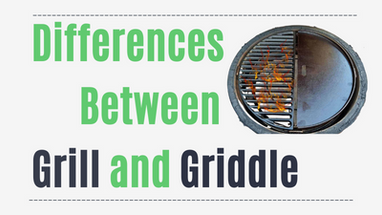Posted by Andrea G on 22nd Jul 2022
Differences between Grill and Griddle
The equipment that you choose for your kitchen will depend on the concept and type of food that you are going to offer in your restaurant. Among the equipment that most lends itself to confusion, are grills and griddles, so we will show you a detailed list of the differences, pros, and cons of each one.
Physical Characteristics & Uses of a Grill
Grilling is a type of cooking that involves creating fire below the food. Grills have distinctive ridges that leave "grill marks" on anything you cook so they are perfect for cooking hamburgers, steaks, pork chops, sandwiches, and all kinds of vegetables. Grills also keep cooked food separated from its grease, which reduces the overall fat content of the food. Most grills include a recessed area that collects fat during the cooking process.
Pros of Grills
- Grills are super easy to use, only fire your grill and throw some steaks, burgers, or chicken on the grates. They don’t require any type of oil for cooking.
- You can make checkered sear marks and sear any type of food to perfection.
- Grills produce flavorful food! Some grills will produce more smokey flavor than others, but even on a gas grill some smokey flavor will absorb into your food. When your meat drippings hit the bottom of the grill, the drippings will vaporize as smoke and rise to flavor your food.
- Grills are easy to clean and maintain day by day.
Cons of Grills
- Deep cleaning a grill takes a bit of work. About once every 6 months you should deep clean your grill, and this process can be a bit time-consuming.
- Cleaning a grill will require a scrubbing brush to get the stubborn bits out, sometimes you’ll need to remove your grates and clean underneath if grease gets there.
Physical Characteristics & Uses of a Griddle
A griddle has a smooth flat surface. They are perfect for cooking all-day foods like: bacon, hamburgers, hot dogs, pancakes, quesadillas, French toast, grilled cheese sandwiches, and anything else you'd cook in a skillet. The best thing about griddles is that they are rectangular, giving you more room to cook than a standard round pan.
Pros of Griddles
- Griddles are super versatile. You can cook any type of meat, veggie, or even breakfast food.
- Griddles cook food more evenly across their entire surface, leaving a solid golden coating on the outside of the meat or pancake.
- The cleaning process is simple. A little care must go into maintaining your griddle surface, but it’s quick and easy.
- Griddles also get extra points for being able to whip up breakfast foods too. Whether it’s sausage, bacon, pancakes, or eggs, the flat surface makes it possible.
Cons of Griddles
- Quality griddles are expensive.
- They require constant oil for cooking.
Griddle vs Grill
Grills produce smoke during cooking, and they usually absorb it into the food, you can expect a lot of smoky flavors to come out of the grill. This gives grilled food a unique and classic smoky flavor that everyone loves.
Griddles, on the other hand, are like cooking in a skillet. They do the same job as a skillet, but provide a larger workspace, and have built-in heating. The food will have a crispy coating on the outside thanks to the fact that the entire piece of meat contacts the cooking surface when on the griddle. Therefore, the food tastes like normal sauteed or seared food, as opposed to the smoky flavor that results from grilling.
On a griddle you can only make foods like pancakes or eggs, a griddle is ideal for foods that start as dough and liquid mixes, such as pancakes, eggs, and almost all breakfast foods.
One of the most significant differences between a grill and a griddle is the cooking temperature. Grills mainly cook food high and fast—they can easily reach temperatures of 400 degrees Fahrenheit or more.
We hope this guide has been useful to you! If you have more questions, call us or visit our website Leasetaurant for more information.



